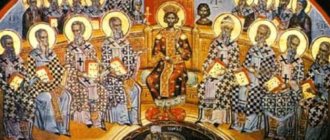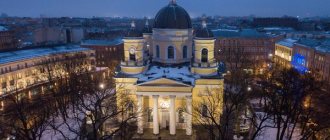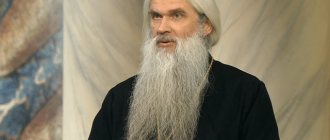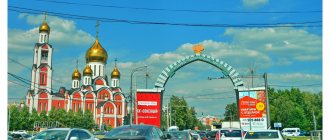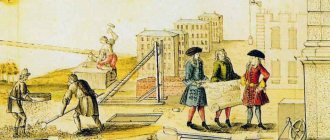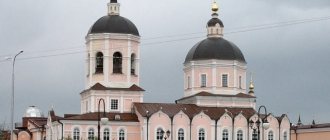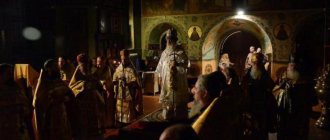Local Council: questions and answers
On the eve of the Local Council of the Russian Orthodox Church, interest in the topic of Church Councils and the tradition of holding them in the Russian Church has increased significantly.
The most frequently asked questions in this regard were commented on by the scientific consultant of the Press Service of the Bishops' and Local Councils of the Russian Orthodox Church, secretary of the Academic Council of the Moscow Theological Academy, associate professor Archpriest Pavel Velikanov, editor-in-chief of the portal "Bogoslov.ru". — Father Paul, please tell us what a Local Council is?
What place does he occupy in the system of church authority? — The Local Council is included in the system of bodies of supreme church power and administration along with the Council of Bishops, as well as the Holy Synod, headed by His Holiness the Patriarch of Moscow and All Rus'.
In the system of higher church government, the Local Council, according to paragraph 1 of section II of the Charter of the Russian Orthodox Church of 2000, is the body of the highest church authority in the field of doctrine and canonical dispensation.
The Council consists of archpastors, representatives of the clergy, monastics and laity, and is authorized to interpret church teaching, resolve canonical, liturgical and pastoral issues, canonize saints, determine and correct the principles of relations between the Church and the state. The exclusive prerogative of the Local Council is the election of the Patriarch of Moscow and All Rus'.
—Who has the right to convene a Local Council?
— The Council has no periodicity in its convening. It is convened depending on the urgent need according to the appropriate decision, which must be made by the Council of Bishops, or, in exceptional cases, by the Patriarch (Locum Tenens) and the Holy Synod. An exceptional case that gives the right to the Locum Tenens and the Holy Synod to make a decision on convening a Local Council is the death of His Holiness the Patriarch.
— Tell me, please, who, how and why made the decision to convene the Local Council in 2009?
— The decision to convene the Local Council and hold it from January 27 to January 29, 2009 was made at a meeting of the Holy Synod of the Russian Orthodox Church, which took place at the Patriarchal residence in the St. Daniel Monastery under the chairmanship of the Locum Tenens of the Patriarchal Throne on December 10, 2008 (journal no. 96). The synodal meeting was also attended by members of the Holy Synod, both permanent and temporary, summoned to the current session.
The convening and holding of the Council was caused by the death of His Holiness Patriarch Alexy II of Moscow and All Rus' and the need to elect a new Primate of the Russian Orthodox Church, as stated in paragraph 16 of Chapter IV of the 2000 Charter.
A Local Council, if convened not by the Council of Bishops, but by the Patriarch (Locum Tenens of the Patriarchal Throne) and the Holy Synod, as was the case on December 10, 2008, must necessarily be preceded by a Council of Bishops. The Synod decided to hold a meeting of the Council of Bishops in the Cathedral of Christ the Savior from January 25 to January 26, 2009 (magazine No. 96).
— Could you explain what documents regulate the work of the Local Council?
— The main document on which the Local Council relies in its work is the Statute of the Russian Orthodox Church of 2000. The Charter contains a list of documents regulating the work of the Local Council. These include: the program of meetings of the Council, the agenda, the rules of the meetings and the structure of the Council. Since the Local Council of 2009 is convened by the Locum Tenens of the Patriarchal Throne and the Holy Synod, the drafts of the above documents are first approved by the Council of Bishops and then submitted for approval by the Local Council.
A specially created Commission for the preparation of the Local Council of the Russian Orthodox Church developed draft programs of meetings, agendas, and regulations for meetings, which were proposed for consideration by the Council of Bishops at the meeting of the Holy Synod on December 24, 2008 (journal No. 104) under the chairmanship of the Locum Tenens of the Patriarchal Throne.
— Why is it necessary to hold a Council of Bishops on the eve of the Local Council?
The 2000 Charter demands that a Council of Bishops be held on the eve of the Local Council. Moreover, the Council of Bishops precedes the meetings of the Local Council, regardless of who initiated the convening of the Local Council: the Patriarch (Locum Tenens) and the Holy Synod or the Council of Bishops itself. The latter is responsible for preparing the Local Council.
The Council of Bishops develops, preliminarily approves and submits for consideration to the Local Council the program of meetings, agenda, rules of the meetings and structure of the Council (or approves these documents in the event of convening the Council by the Patriarch (Locum Tenens) and the Holy Synod), makes other decisions related to the conduct of the Local Council .
The holding of the Council of Bishops on January 25-26, 2009 is also necessary in order to elect by secret ballot three candidates for the Patriarchal throne who meet the requirements imposed on them by the Charter.
— Tell me, please, who determines the composition of the participants of the Local Council?
— The Charter of 2000 establishes the norm on the composition of the Local Council from bishops (both diocesan and vicar, who are members of the Council by position), as well as representatives of the clergy, monastics and laity (the number and procedure for electing the last three categories are established by the Council of Bishops).
In exceptional cases, the Charter provides the opportunity to establish a procedure for electing delegates from the clergy, monastics and laity and their quota to the Holy Synod. The decision of the Synod in this case is subject to approval by the Council of Bishops. Based on this norm, the Holy Synod on December 10, 2008 adopted the “Regulations on the composition of the Local Council” (Journal No. 96), which detailed the instructions of the Charter on the composition of the Council.
According to the “Regulations,” the members of the Local Council are: heads of synodal institutions (Administration of the Moscow Patriarchate, Department for External Church Relations, Publishing Council, Educational Committee, Department of Catechesis and Religious Education, Department of Charity and Social Service, Missionary Department, Department for Cooperation with the Armed Forces and law enforcement agencies, the Department for Youth Affairs), rectors of the Theological Academies and the Orthodox St. Tikhon's Humanitarian University, vicars of stauropegial male monasteries in the episcopal rank, head of the Russian Spiritual Mission in Jerusalem, members of the Commission for the preparation of the Local Council of the Russian Orthodox Church (its personal composition was approved at the meeting of the Holy Synod on December 10, 2008 (magazine No. 96)).
In addition, according to a quota, five delegates are elected from the Theological seminaries at the rector's meeting, and four delegates are elected from the women's stauropegic monasteries at the congress of their abbess.
According to paragraph 11 of the “Regulations on the composition of the Local Council”, three delegates are elected from each diocese of the Russian Orthodox Church (one cleric, one monastic and one layman), and two delegates are elected from the Patriarchal parishes in Canada, the USA and the Scandinavian countries (a clergyman and layman).
By the resolution of the Holy Synod of December 24, 2008 (journal No. 105), the list of Patriarchal parishes, each representing two delegates to the Council, was expanded to include the Patriarchal parishes in Turkmenistan and Italy.
— How do elections of delegates to the Council take place in dioceses or Patriarchal parishes?
— The Charter of 2000 and the “Regulations on the composition of the Local Council” dated December 10, 2008 do not regulate the procedure for electing delegates to the Council.
The “Regulations” indicate that delegates to the Council are elected by the diocesan meeting (the general parish meeting in relation to the Patriarchal parishes in Canada, the USA, Turkmenistan, Italy and the Scandinavian countries) according to the procedure established by the meeting itself from persons of the Orthodox confession who meet the qualities specified in paragraph 32 of Chapter XI of the Charter for members of parishes of the Russian Orthodox Church and living in the territory of the diocese (parish) from which they are elected.
— Can anyone besides its participants take part in the meetings of the Council?
— The Charter in paragraph 16 of Section II provides for the possibility of participation in open meetings of the Council, in addition to the members of the latter, invited theologians, specialists, observers and guests (the logic of the Charter does not allow such participation in closed meetings). The degree of participation of invited persons in council meetings differs from that which concerns members of the Council. The Charter states that in any case, invited persons have no right to vote.
— Could you remind me what requirements are imposed on candidates for the Patriarchal throne?
— A candidate for Patriarch must be a bishop of the Russian Orthodox Church and meet the requirements imposed on him in paragraph 17 of Section IV of the Charter, namely: have a higher theological education, sufficient experience in diocesan administration, be distinguished by a commitment to canonical law and order, enjoy both a good reputation and the trust of the hierarchs and clergy and the people, so also “have a good testimony from outsiders” (1 Tim. 3:7). The age of a candidate for the Patriarchal throne must not be less than forty years.
— When and in connection with what were Local Councils of the Russian Orthodox Church convened in the twentieth century?
— In the twentieth century, several Local Councils of the Russian Orthodox Church took place, for most of which the main actions were the election of the Primates of the Russian Church and the adoption of regulations and statutes on the governance of the Russian Orthodox Church.
The All-Russian Church Council of 1917-1918, for example, adopted definitions that reformed the highest church administration and diocesan administration, as well as definitions on many issues of the internal life of the Church. The Council approved the conciliar-patriarchal form of higher church government and elected St. Tikhon (Belavin) to the All-Russian Patriarchal Throne. In a special section of the portal “Bogoslov.ru”, which is dedicated to issues of Councils and the Patriarchate, almost all documents related to these councils are posted - resolutions, acts, biographies of council members, reviews of sessions.
The next Local Council in 1945 was convened in connection with the death of His Holiness Patriarch Sergius (Stragorodsky). The Council elected Metropolitan Alexy (Simansky) to the Patriarchal Throne and adopted the “Regulations on the Administration of the Russian Orthodox Church,” which was a legal act that eliminated the vacuum of legal regulation of the activities of the highest administration of the Russian Orthodox Church.
The Local Council of 1971 was convened in connection with the death of His Holiness Patriarch Alexy I (Simansky). The participants of the Council elected Metropolitan Pimen (Izvekov) Patriarch of Moscow and All Rus'.
The Local Council of 1988 was dedicated to the Millennium of the Baptism of Rus'. At this Council, the “Charter on the governance of the Russian Orthodox Church” was adopted, which absorbed much of what the All-Russian Church Council of 1917-1918 achieved in the structure of the highest church government. The undoubted advantage of the 1988 Charter was the legal regulation of the status, competence, composition, internal structure, order of work and decision-making of the Council of Bishops, which neither the definitions of the Council of 1917-1918 nor the Regulations of 1945 knew.
The Local Council of 1990 was convened in connection with the death of His Holiness Patriarch Pimen (Izvekov). The Council elected Metropolitan Alexy (Ridiger) to the Patriarchal Throne, who served as primate in the Russian Orthodox Church until his blessed death on December 5, 2008.
— What issues besides the election of the Patriarch will be discussed at the upcoming Local Council?
— Specific issues on the agenda of the Local Council are finally formed by the Council of Bishops, which submits them for approval by the Local Council. When approving the agenda, the latter has the right to make changes to it, adding new issues for consideration.
— As you know, at the end of the Local Council the enthronement of the new Primate of the Russian Church will take place. Could you explain the meaning of this term in its ecclesiastical meaning?
— The term “enthronement” literally means “enthronement,” the equivalent of which in Church Slavonic is “enthronement.” Enthronement is a solemn service during which the newly elected Patriarch is elevated to the Patriarchal See. In ancient times, the bishop's chair was the bishop's seat (throne), which was located on a high place; subsequently the pulpit was moved to the center of the temple.
Ancient temples of the 5th-6th centuries have still been preserved, in which the pulpit is a significantly raised place - up to several meters, to which several stairs lead. During non-liturgical times, the department of the Patriarch in Rus' was located to the right of the Royal Doors, while the royal seat was on the left, at the right front pillar of the temple.
— How, according to tradition, does the enthronement of an elected Patriarch take place in the Russian Orthodox Church?
— Enthronement takes place during the Divine Liturgy with the vesting of the newly elected Patriarch in Patriarchal robes and the presentation of the Patriarchal staff to him. The robes of the Primate of the Church have a number of differences from the robes of other bishops. This is, first of all, a special headdress - a white kukol, on the frontal side and front ends of which images of six-winged seraphim are embroidered, and on the top of the Patriarchal kukol there is a cross. The Patriarchal Robe has a different color - green, while for metropolitans it is blue, and for the rest of the bishops it is purple.
During the service, the Patriarch wears two panagias and a cross, which is also a special distinction. It is also worth mentioning the Patriarchal insignia (signs of authority), which distinguish the Patriarch's divine service from the usual bishop's service. This is a cross, an eagle, which in medieval Rus' was a sign of the Patriarchal divine service, as well as the Patriarchal staff and Jerusalema - special vessels with which the Patriarchal deacon performs incense.
More details about these and other features of the vestments and worship of the Patriarch, as well as about the history of enthronement in Byzantium and Rus', can be found on the portal “Theologian.ru” in the section dedicated to Councils and the Patriarchate.
Meetings of autocephalous Churches
Now this is the name given to bishops and believers representing the fullness of a particular Local Church (in Greek – “τοπικε ἐκκλησία”, literally – “local” community), who gather to make decisions that are important for the entire Christian community.
Such a meeting can be held by an independent, or “autocephalous” Christian community. There are now 15 of them (including the Russian Church). Some of them, like Jerusalem, Antioch, Alexandria, originate from the Apostles, others emerged in later times.
This is interesting: Why autocephaly is not always a good thing
What is the difference from the Ecumenical Council
On the most important issues concerning all Christians, and not just the Church, more representative meetings are convened, to which local communities send delegates. They can resolve issues:
- dogmas, their understanding, interpretation;
- canons, church legislation, charter.
Such a meeting is usually called Ecumenical, that is, representing the entire fullness of the Church. However, it receives its status not by the number of participants from different communities, but by whether the church people, the Local Churches, recognize the decisions made. Therefore, in canon law there is the concept of reception, or recognition, acceptance. It sometimes occurs over a fairly long period, which can take decades.
Useful materials
Thus, on the issue of the God-manhood of Christ, Ecumenical Councils were held twice, in 325 and 381. The disputes ended with the final approval of the understanding of Christ as God and Man.
Interesting fact
The last (Seventh) Ecumenical Council was held on the issue of veneration of icons (787).
Inter-conciliar period
In pursuance of the decision of the Council of Bishops, a four-party (Moscow Patriarchate, Ukrainian Orthodox Church, Vatican, Greek Catholic Church in Ukraine) commission was created to regulate relations between Orthodox and Catholics of the Eastern rite in the western regions of Ukraine. During its meetings on March 8-13 in Lviv, the commission developed practical solutions for the distribution of churches between Orthodox and Uniates. However, on March 22, a statement was published by the Greek Catholic Church in Ukraine, which stated that, in agreement with Pope John Paul II, all documents of the commission were recognized as unauthorized, after which the Uniates withdrew from the commission. Cases of seizures of churches multiplied and on April 10, the Holy Synod of the Russian Orthodox Church again protested against such actions.
The death of Patriarch Pimen on May 3 pushed the Ukrainian issue into the background. On the same day, at a meeting of the Holy Synod, Metropolitan of Kiev Filaret (Denisenko) was elected locum tenens of the patriarchal throne. At the meeting of the Synod on May 8, the dates for the next Council were approved.
Also in May, the Council of Bishops of the Russian Orthodox Church Outside of Russia made a decision to open its parishes and dioceses within the USSR. The Foreign Synod called on the clergy and laity of the Moscow Patriarchate to move to its jurisdiction. Although only a small number of clergy followed this call, the new situation became another challenge to the unity of the Russian Church.
How often does it happen?
There is no uniform frequency of convocations for all; each Church decides this independently. Usually a meeting is scheduled as needed, depending on the circumstances of church life.
Authority
Meeting of bishops, clergy, laity:
- elects a primate or removes him from the patriarchate (for example, such a problem was discussed in Russia in 1666-67, when there was a question of trial in the “case of Patriarch Nikon”);
- approves resolutions of meetings of bishops;
- canonizes saints;
- discusses other issues of worship, canons, Charter, and intra-church life in general.
For Local decisions there is also the concept of reception, or recognition of the decision by the Church's completeness. Therefore, although decisions are binding on everyone, they are not always implemented immediately.
